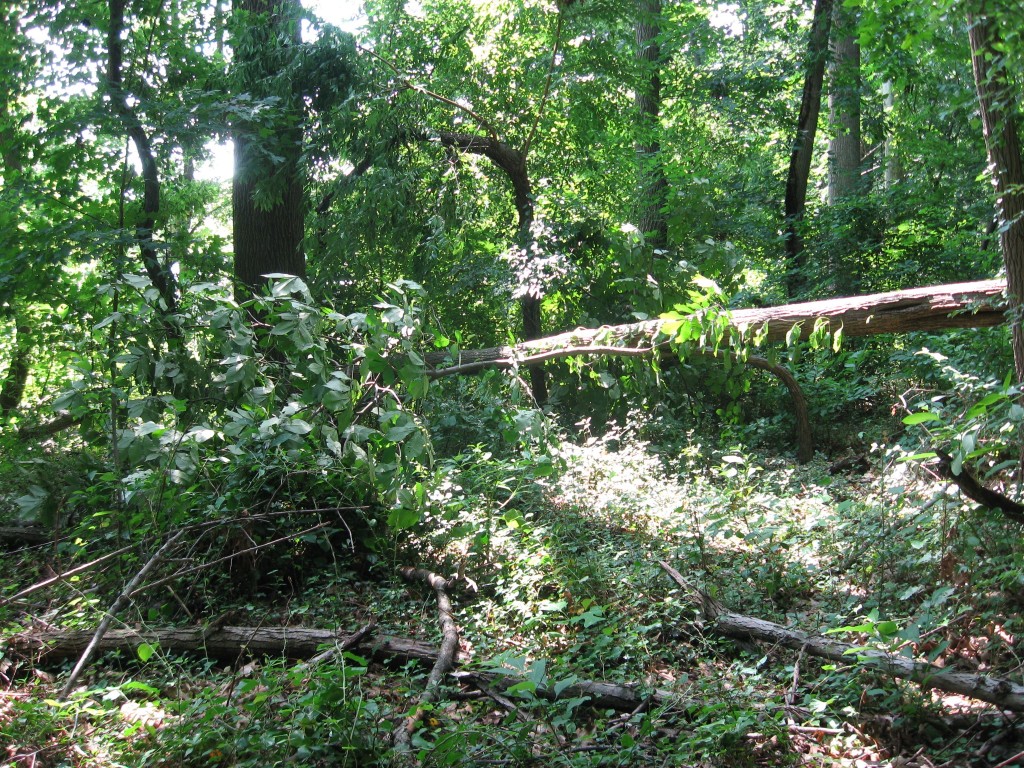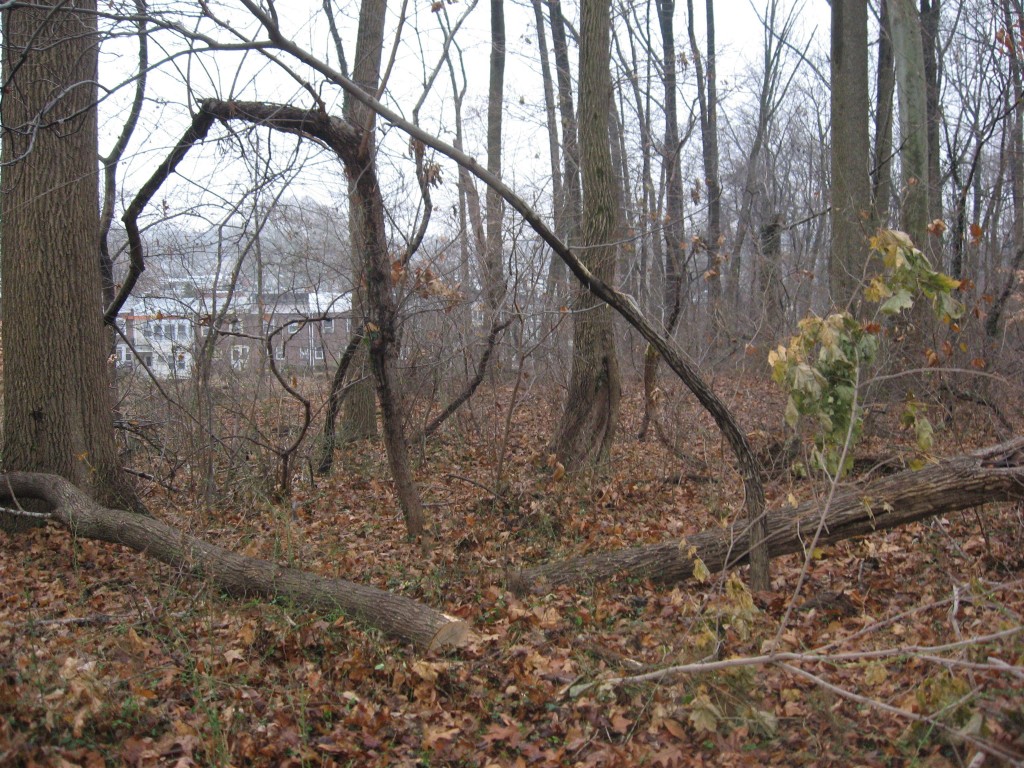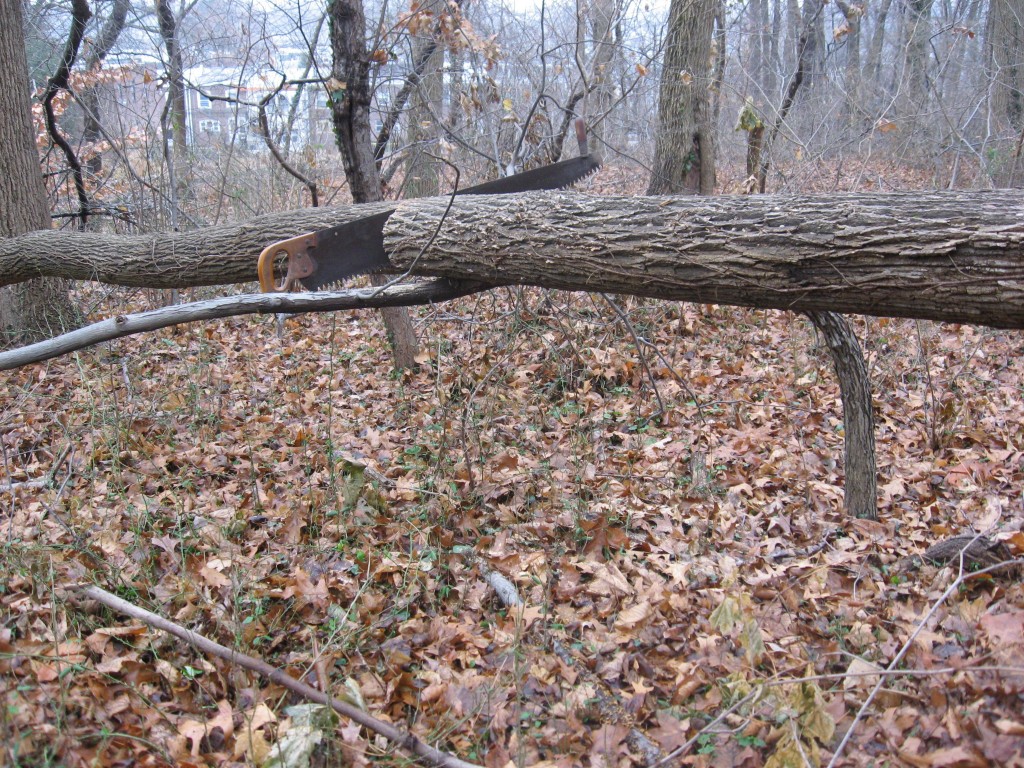This past August, 2012, another dying Ash tree crashed to the ground, taking down with it a young Hickory Tree. Â The Hickory tree was bent all the way down, but not cracked on its main trunk. On further inspection a lower branch was severed.
This is a part of the forest that is close to the edge of Morris Park, and there are many invasives in this area, which we regularly remove, such as the Japanese Angelica Tree (Aralia elata), the Tree of Heaven (Ailanthus altissima), Norway Maple, The Burning Bush, (Euonymus alatus), Japanese Privet, English Ivy, Japanese Pachysandra, Garlic Mustard (Alliaria petiolata) and the Vinca Vine.
We are trying to maintain the existing forest and to encourage the future forest in this challenging area full of garden escapes. Â There was some discussion about the best way to handle this immediate problem. How to get that dead ash tree off of the Hickory.
As far as the why bother is concerned, there is the #1 issue of the invasives taking every opportunity to dominate, and the #2 ongoing land management issue. In this degraded urban forest situation, it is us community members that care enough to become land managers, and do what we can to protect and preserve this small portion of  the 9000 acres of Fairmount Park.  In the area of scope that we concern ourselves with, every tree is given thoughtful consideration. As a sanctioned volunteer group, our permit does not allow us to use chainsaws, but we are allowed to use handtools.

As pictured below, this hand-saw was able to cut through the fallen ash tree as if it were a stick of butter. It went so fast, there was barely time to stop long enough for a photo. Â No need for a chainsaw in this specific situation.
How could this be, no chainsaw, and the job done? Â It all started with the Flea market at the Eastern State Penitentiary in Fairmount, Spring 2005. This Philadelphia-Made Disston saw was purchased for the asking price of $20.00.
It was an old looking 19th century rusty old thing. Â It is a two person saw, and if you look at the end in the picture below, you will see a handle rising above the very end of it. This saw sat for some time in the basement of our Parkside office until it was time for it to rise to the call of duty.
The saw needed some basic restoration before it could become the amazing steel slicing mechanism and the natural extension of our appendices it has become: A fine file was purchased, as well as some 100 Â and 150 grit sandpaper and a tin of 5 and 1 oil. Â First, the blade was sanded down, to remove the small amounts of rust that have accumulated on this fairly well- preserved saw. Then after this five minute exercise was completed, the filing of the blades commenced.
The one inched long teeth, numbering to into the 70s, required a light filing, each and every one. Just like how we engage  and manage each and every  tree in our current area of scope in Morris Park, every tooth of this saw was sharpened in an exercise that took about one hour. Than the saw was oiled with the Five and One. The restoration took all said and done, about one hour and fifteen minutes. The gleaming, super-sharp hand-saw was ready for the job.
Most inspiring is a photograph that shows workers at a Disston Saw plant in Philadelphia hand- sharpening each tooth of a really large 7 or 8 foot in diameter blade. So thats how its done.  Hate to think of what trees these old blades cut  through though.
The Disston  hand-saw is no longer made. These products are easily found (for now), and easily rehabilitated.
The Ash tree was cut, and the Hickory Tree, liberated from the weight, Â rebounded into the air on this fine Monday, December 17, 2012.
Watch it go up!
So the time has come where we Humans are in charge of the great forests. We need to manage them, controlling invasives and encouraging native trees and now we even find ourselves controlling native species that have gone out of their natural controls, due to human-induced habitat and species loss.





Disston is no more? I think I have a Disston tool in the basement. Need to check.
I wrote that Disston is no more, and while the original factory, and products are no longer in existence, the company has been sold off and has undergone various iterations, and the name still exists as Disston Precision, located in Philadelphia, according to Wikipedia. The Disston Hand Saw is no longer made, so I adjusted the text accordingly.
My long winded reply disappeared. Sorry.
Yeah, using wordpress requires some patience as well. Just about anything with computers requires patience. Getting used to the i pad, dealing with facebook, keeping the old (2010) model mac laptop running smoothly all require patience in the the highest order. Really, patience is a virtue, but if any of us get so virtuous about not losing patience that we become righteous about it,then we have again lost our patience……
Please note gmail address..your software will not accept my normal email address.
I am admiring the patience you have acquired. It is so Impressive when I consider you were raised by such an impatient parent as myself. I can’t imagine sanding the edges of 70 sawteeth!!.
I guess this kind of viewpoint is essential when you view the entire forest as your garden!!!!!
M
Is patience inheritable or is it passed on? Who has patience for anything anymore anyway? Patience is still a good trait, meditative, number one, and it is still required to get the job done in a satisfactorily thorough manner.
Nice job
Thanks, Cormac!
We would do well to replace the ideal of ‘wilderness’ … as thought there were anything outside the domain of human intervention. If we–by choice or accident–can change the very climate, there is nothing left that doesn’t bear the weight of our presence. But what a noble idea role that we’re left… “we are the gardeners of the world.’ That is–not the controlling managers, but the caretakers, who take our instructions from the realm we are entrusted to protect, rather than insisting on being the boss and making “nature” to our will.
I put quotes around that word.. ‘nature’… because this is one of those old ideas we need to disabuse ourselves of if we are to survive. Nature has meaning only as something opposed to what we call, human culture. As though, in all this vast universe–we are so special as to require a separate ontological identity, defining ourselves in opposition, to all the rest. What nonsense!
We are animals, eating and defecating and reproducing not that different in any way from other animals, but for our ability to imagine ourselves superior, and our capacity to build and invent rather more freely than our fellow creatures. We too, are nature. And if nature is everything… and it is, than the word really has no meaning. No use. We are not the Great Other… but are of in our evolution and in mutual dependency, all of what we would place outside of our imaginary privileged status.
As in all things… it’s time and past time to leave our privilege behind. Like all our fellow creatures, we look out for our own. Protect our progeny. But we can do this in cooperative, contractual relationship with our fellow beings–all of them, animal, plant, organic and inorganic. Contractual–because we accept what they give that we may live, and we give back in return… as caretakers. As the gardeners of the world… not our world… entering at last, a world no one owns.
Jacob, Thanks for your thoughts! Humans do need to collectively realize how dependent on other species and the ecosystems they create that sustain our lives. At the same time, there needs to economic and social equality, so deforestation, poaching, pollution, etc isnt occurring by desperate humans.